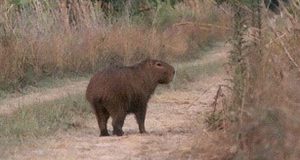Abstract
Would you know what to do if you saw a two-foot-tall, 100-pound exotic rodent strolling through your neighborhood? It’s highly unlikely, but, depending on your location, not absolutely impossible. Capybaras, the world’s largest rodents, are native to South America but have been spotted in the state of Florida and may have potential to establish populations here. This 5-page fact sheet written by Brandon Parker, C. Jane Anderson, Christina Romagosa, Samantha Wisely, Daniel Pearson, John Seyjagat, and Katherine Ashley Sayler and published by the UF/IFAS Department of Wildlife Ecology and Conservation describes capybaras, explains how they got to Florida, and shows where the semiaquatic, herbivorous rodents have been sighted so far.
edis.ifas.ufl.edu/uw438
References
Alho, C. J., and N. L. Rondon. 1987. "Habitats, population densities, and social structure of capybaras (Hydrochaeris hydrochaeris, Rodentia) in the Pantanal, Brazil." Revista Brasilerira de Zoologia. 4(2): 139-149. doi:10.1590/S0101-81751987000200006 https://doi.org/10.1590/S0101-81751987000200006
Azara, F. 1802. Apuntamientos para la historia natural de los quadrúpedos del Paraguay y río de la Plata. Madrid: Imprenta de la Viuda de Ibarra.
Benson, A. 2017. Hydrochoerus hydrochaeris (Linnaeus, 1766). Retrieved on August 23, 2017 from https://nas.er.usgs.gov/queries/FactSheet.aspx?speciesID=2587.
Campos-Krauer, J. M., and S.M. Wisely. 2011. "Deforestation and cattle ranching drive rapid range expansion of capybara in the Gran Chaco ecosystem." Global Change Biology. 17(1): 206-218. doi:10.1111/j.1365-2486.2010.02193.x https://doi.org/10.1111/j.1365-2486.2010.02193.x
Campos-Krauer, J. M., S. M. Wisely, I. K. Benitez, K. Robles, and R. T. Golightly. 2014. "Home range and habitat use of capybara in newly invaded pastureland in the dry Chaco region of Paraguay." Therya. 5(1): 61-79. doi:10.12933/therya-14-177 https://doi.org/10.12933/therya-14-177
Cueto, G. R. 2013. "Diseases of Capybara." In Moreira, J. R., Ferraz, K. M., Herrera, E. A., and D. W. Macdonald (Eds.), Capybara: biology, use and conservation of an exceptional neotropical species (pp. 169-177). New York, NY: Springer Science & Business Media. Retrieved July 18, 2017, from https://link.springer.com/content/pdf/10.1007%2F978-1-4614-4000-0_9.pdf.
Dantes-Torres, F. 2007. "Rocky Mountain spotted fever." Lancet Infectious Diseases. 7(11): 724-732. doi:10.1016/S1473-3099(07)70261-X https://doi.org/10.1016/S1473-3099(07)70261-X
Desquesnes, M., P. Holzmulle, D. Lai, A. Dargantes, Z. Lun, and S. Jittaplapong. 2013. "Trypanosoma evansi and surra: A review and perspectives on origin, history, distribution, taxonomy, morphology, hosts, and pathogenic effects." BioMedical Research International. 2013: 1-22. doi:10.1155/2013/194176 https://doi.org/10.1155/2013/194176
Desbiez, A. L. J., S. A. Santos, J. M. Alvarez, and W. M. Tomas. 2011. "Forage use in domestic cattle (Bos indicus), capybara (Hydrochoerus hydrochaeris) and pampas deer (Ozotoceros bezoarticus) in a seasonal neotropical wetland." Mammalian Biology 76(3): 351-357. doi:10.1016/j.mambio.2010.10.008 https://doi.org/10.1016/j.mambio.2010.10.008
Early Detection and Distribution Mapping System (EDDMapS). 2017. Capybara Hydrochoerus hydrochaeris. Retrieved on August 16, 2017 from https://EDDMapS.org/distribution/viewmap.cfm?sub=10381.
Felix, G., I. Almeida, U. Piovezan, R. Garcia, K. Lima, I. Nääs, D. Salgado, M. Pilecco, and M. Belloni. 2014. "Feeding behavior and crop damage caused by capybaras (Hydrochoerus hydrochaeris) in an agricultural landscape." Brazilian Journal of Biology. 74(4): 779-786. doi:10.1590/1519-6984.02113 https://doi.org/10.1590/1519-6984.02113
Ferraz, K., M. Lechevalier, H. Couto, and L. Verdade. 2003. "Damage caused by capybaras in a corn field." Scientia Agricola. 60(1): 191-194. doi:10.1590/S0103-90162003000100029 https://doi.org/10.1590/S0103-90162003000100029
Florida Fish and Wildlife Conservation Commission. 2017a. Nonnative Mammals. Retrieved on August 22, 2017 from http://myfwc.com/wildlifehabitats/nonnatives/mammals/.
Florida Fish and Wildlife Conservation Commission. 2017b. Captive Wildlife Licenses & Permits. Retrieved on August 22, 2017 from http://myfwc.com/license/captive-wildlife/.
Florida Fish and Wildlife Conservation Commission. 2017c. Florida's Exotic Fish and Wildlife. Retrieved on November 26, 2017 from http://myfwc.com/wildlifehabitats/nonnatives/.
Gutierrez, C., M. Desquesnes, L. Touratier, and P. Büscher. 2010. "Trypanosoma evansi: Recent outbreaks in Europe." Veterinary Parasitology. 174(1): 26-29. doi:10.1016/j.vetpar.2010.08.012 https://doi.org/10.1016/j.vetpar.2010.08.012
Labruna, M. 2013. In Moreira, J. R., K. M. Ferraz, E. A. Herrera, and D. W. Macdonald (Eds.), "Brazilian spotted fever: The role of capybara." Capybara: biology, use and conservation of an exceptional neotropical species (pp 371-383). New York, NY: Springer Science & Business Media. Retrieved July 18, 2017, from https://link.springer.cottim/content/pdf/10.1007%2F978-1-4614-4000-0_23.pdf.
Mones, A., and J. Ojasti. 1986. "Hydrochaeris hydrochaeris." Mammalian Species. 264: 1-7. Retrieved December 13, 2017, from https://academic.oup.com/mspecies/articleabstract/doi/10.2307/3503784/2600593?redirectedFrom=fulltext https://doi.org/10.2307/3503784
Nowak, R. 1999. Walker's Mammals of the World (Vol. 2, 6th ed., pp. 1673). Baltimore, MD:Johns Hopkins University.
United States Department of Agriculture. 2017. 2016 Florida Agriculture Overview. Retrieved on August 1, 2017 from https://www.nass.usda.gov/Quick_Stats/Ag_Overview/stateOverview.php?state=FLORIDA.
Unless otherwise specified, articles published in the EDIS journal after January 1, 2024 are licensed under a Creative Commons Attribution-NonCommercial-NoDerivs 4.0 International (CC BY-NC-ND 4.0) license.


